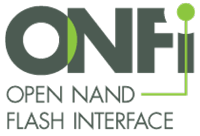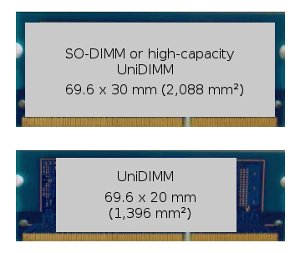Related Research Articles

Computer memory stores information, such as data and programs, for immediate use in the computer. The term memory is often synonymous with the terms RAM,main memory or primary storage. Archaic synonyms for main memory include core and store.

Double Data Rate Synchronous Dynamic Random-Access Memory is a double data rate (DDR) synchronous dynamic random-access memory (SDRAM) class of memory integrated circuits used in computers. DDR SDRAM, also retroactively called DDR1 SDRAM, has been superseded by DDR2 SDRAM, DDR3 SDRAM, DDR4 SDRAM and DDR5 SDRAM. None of its successors are forward or backward compatible with DDR1 SDRAM, meaning DDR2, DDR3, DDR4 and DDR5 memory modules will not work on DDR1-equipped motherboards, and vice versa.

A DIMM, or Dual In-Line Memory Module, is a type of computer memory module used in desktop, laptop, and server computers. It is a circuit board that contains memory chips and connects to the computer's motherboard. A DIMM is often called a "RAM stick" due to its shape and size. A DIMM comprises a series of dynamic random-access memory integrated circuits that are mounted to its circuit board. DIMMs are the predominant method for adding memory into a computer system. The vast majority of DIMMs are standardized through JEDEC standards, although there are proprietary DIMMs. DIMMs come in a variety of speeds and sizes, but generally are one of two lengths - PC which are 133.35 mm (5.25 in) and laptop (SO-DIMM) which are about half the size at 67.60 mm (2.66 in).
Non-volatile random-access memory (NVRAM) is random-access memory that retains data without applied power. This is in contrast to dynamic random-access memory (DRAM) and static random-access memory (SRAM), which both maintain data only for as long as power is applied, or forms of sequential-access memory such as magnetic tape, which cannot be randomly accessed but which retains data indefinitely without electric power.
Non-volatile memory (NVM) or non-volatile storage is a type of computer memory that can retain stored information even after power is removed. In contrast, volatile memory needs constant power in order to retain data.
An in-memory database is a database management system that primarily relies on main memory for computer data storage. It is contrasted with database management systems that employ a disk storage mechanism. In-memory databases are faster than disk-optimized databases because disk access is slower than memory access and the internal optimization algorithms are simpler and execute fewer CPU instructions. Accessing data in memory eliminates seek time when querying the data, which provides faster and more predictable performance than disk.
In computing, a hybrid drive is a logical or physical storage device that combines a faster storage medium such as solid-state drive (SSD) with a higher-capacity hard disk drive (HDD). The intent is adding some of the speed of SSDs to the cost-effective storage capacity of traditional HDDs. The purpose of the SSD in a hybrid drive is to act as a cache for the data stored on the HDD, improving the overall performance by keeping copies of the most frequently used data on the faster SSD drive.
Double Data Rate 3 Synchronous Dynamic Random-Access Memory is a type of synchronous dynamic random-access memory (SDRAM) with a high bandwidth interface, and has been in use since 2007. It is the higher-speed successor to DDR and DDR2 and predecessor to DDR4 synchronous dynamic random-access memory (SDRAM) chips. DDR3 SDRAM is neither forward nor backward compatible with any earlier type of random-access memory (RAM) because of different signaling voltages, timings, and other factors.

In computing, a memory module or RAM stick is a printed circuit board on which memory integrated circuits are mounted. Memory modules permit easy installation and replacement in electronic systems, especially computers such as personal computers, workstations, and servers. The first memory modules were proprietary designs that were specific to a model of computer from a specific manufacturer. Later, memory modules were standardized by organizations such as JEDEC and could be used in any system designed to use them.

A solid-state drive (SSD) is a solid-state storage device that uses integrated circuit assemblies to store data persistently, typically using flash memory, and functions as secondary storage in the hierarchy of computer storage. It is also sometimes called a semiconductor storage device, a solid-state device, or a solid-state disk, even though SSDs lack the physical spinning disks and movable read-write heads used in hard disk drives (HDDs) and floppy disks. SSD also has rich internal parallelism for data processing.

G.SKILL International Enterprise is a Taiwanese computer hardware manufacturing company. The company's target customers are overclocking computer users. It produces a variety of high-end PC products and is best known for its DRAM products.

The Open NAND Flash Interface Working Group is a consortium of technology companies working to develop open standards for NAND flash memory and devices that communicate with them. The formation of ONFI was announced at the Intel Developer Forum in March 2006.
Double Data Rate 4 Synchronous Dynamic Random-Access Memory is a type of synchronous dynamic random-access memory with a high bandwidth interface.

Netlist Inc. is a Delaware-registered corporation headquartered in Irvine, California that designs and sells high-performance SSDs and modular memory subsystems to enterprise customers in diverse industries. It also manufactures a line of specialty and legacy memory products to storage customers, appliance customers, system builders and cloud and datacenter customers. Netlist holds a portfolio of patents in the areas of server memory, hybrid memory, storage class memory, rank multiplication and load reduction. Netlist has more than 120 employees and an annual revenue of US$142.4 million as of 2021 The stock was added to NASDAQ in late 2006. In the initial public offering of its common stock in 2006, Netlist sold 6,250,000 shares at $7.00 each. On September 26, 2018, Netlist announced they were moving from NASDAQ and currently trades on the OTCQB.

Double Data Rate 5 Synchronous Dynamic Random-Access Memory is a type of synchronous dynamic random-access memory. Compared to its predecessor DDR4 SDRAM, DDR5 was planned to reduce power consumption, while doubling bandwidth. The standard, originally targeted for 2018, was released on July 14, 2020.

UniDIMM is a specification for dual in-line memory modules (DIMMs), which are printed circuit boards (PCBs) designed to carry dynamic random-access memory (DRAM) chips. UniDIMMs can be populated with either DDR3 or DDR4 chips, with no support for any additional memory control logic; as a result, the computer's memory controller must support both DDR3 and DDR4 memory standards. The UniDIMM specification was created by Intel for its Skylake microarchitecture, whose integrated memory controller (IMC) supports both DDR3 and DDR4 memory technologies.

3D XPoint is a discontinued non-volatile memory (NVM) technology developed jointly by Intel and Micron Technology. It was announced in July 2015 and was available on the open market under the brand name Optane (Intel) from April 2017 to July 2022. Bit storage is based on a change of bulk resistance, in conjunction with a stackable cross-grid data access array. Initial prices are less than dynamic random-access memory (DRAM) but more than flash memory.
Virtium Solid State Storage and Memory is a privately held American company that manufactures semiconductor memory and solid-state disk (SSD) products for data storage in industrial/machine-to-machine designs, embedded systems, including small-footprint designs, and Industrial Internet of Things (IIoT) applications. The company's primary markets of focus include defense, industrial systems, network communications, and transportation. The name Virtium is derived from the word virtue.

ATP Electronics was a manufacturer of NAND based storage DRAM modules founded in Silicon Valley in 1991, headquarter was later moved to Taipei, Taiwan. ATP’s product line consist of Industrial grade products, such as SSD, SD / microSD memory cards, along with DRAM products that are used in business industries across Networking, Enterprise Mobility, Automotive industry, Military, IPC/Embedded Systems, Health care, Gaming and The Internet of Things (IoT). Intel's CMTL, one of the largest third party testing lab for Intel server platforms, only recommended two memory modules companies to purchase motherboards in Taiwan, one noted to be ATP Electronics.
IBM FlashCore Modules (FCM) are solid state technology computer data storage modules using PCI Express attachment and the NVMe command set. They are offered as an alternative to industry-standard 2.5" NVMe SSDs in selected arrays from the IBM FlashSystem family, with raw storage capacities of 4.8 TB, 9.6 TB, 19.2 TB and 38.4 TB. FlashCore modules support hardware self-encryption and real-time inline hardware data compression up to 115.2 TB address space, without performance impact.
References
- 1 2 Non-Volatile Memory and Its Use in Enterprise Applications (PDF), Viking Technology, SNIA, January 2014
{{citation}}: CS1 maint: others (link) - ↑ Grupp, Laura M.; Davis, John; Swanson, Steven (February 2012). "The Bleak Future of NAND Flash Memory" (PDF). Microsoft Research. Archived (PDF) from the original on 2019-02-10. Retrieved 2014-05-08.
- ↑ Maleval, Jean Jacques (2013-03-11). "SSDs Risk Massive Data Loss" . Storage Newsletter. Retrieved 2013-09-06.
- ↑ Clarke, Peter (14 April 2020). "First carbon nanotube NRAM products due in 2020, says Nantero". eenewsanalog.com. European Business Press. Retrieved 19 September 2020.
- ↑ Golander, Amit (2015-08-23). "Welcome to the era of NVDIMM Cards". Plexistor. Archived from the original on 2018-12-23. Retrieved 2015-08-23.
- ↑ "JEDEC Publishes DDR4 NVDIMM-P Bus Protocol Standard". JEDEC. 2021-02-17. Retrieved 2021-02-17.
- ↑ Crump, George (2012-10-02). "Does DRAM Storage Still Make Sense?". Storage Switzerland. Archived from the original on 2013-06-16.
- ↑ Mah Ung, Gordon (2015-08-21). "Intels crazy fast 3D XPoint Optane memory heads for DDR slots but with a cache". PCWorld . Archived from the original on 2015-08-23. Retrieved 2015-08-21.
- ↑ Russell, Gil (2015-08-11). "Viking technology and Sony in ReRAM memory mashup". TechEye. Archived from the original on 2016-04-16. Retrieved 2015-08-11.
- ↑ Armstrong, Adam (2015-11-19). "Netlist And Samsung Partner To Deliver NVDIMM-P". Storage Review. Archived from the original on 2021-01-02.
- ↑ "JEDEC announces support NVDIMM hybrid memory modules". JEDEC. 2015-05-26. Archived from the original on 2016-04-24. Retrieved 2015-05-26.
- ↑ Larabel, Michael (2015-05-21). "ACPI 6 Non-Volatile Memory Device Support NFIT libND For Linux". Phoronix . Archived from the original on 2018-12-23. Retrieved 2015-05-21.
- ↑ Verity, John W. (2012-09-19). "Non-Volatile DRAM Is Poised to Give Apps a Big Boost". Datacenter Acceleration. Archived from the original on 2013-06-16. Retrieved 2013-09-06.